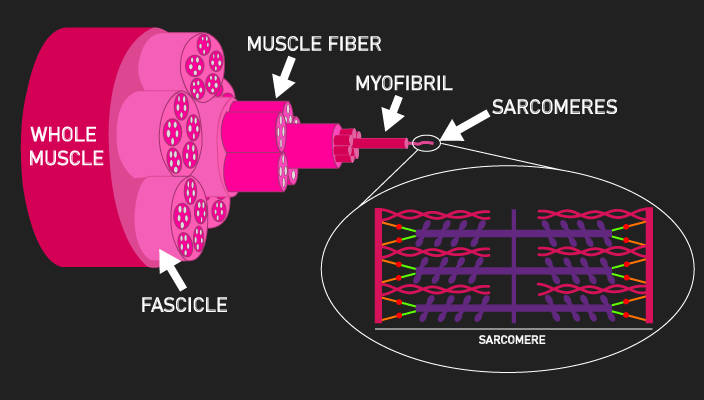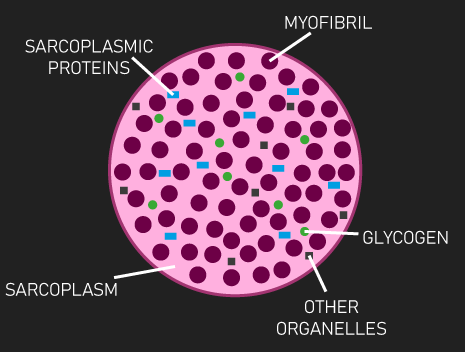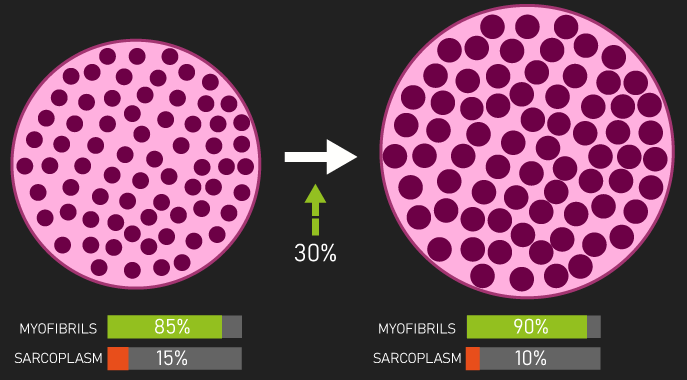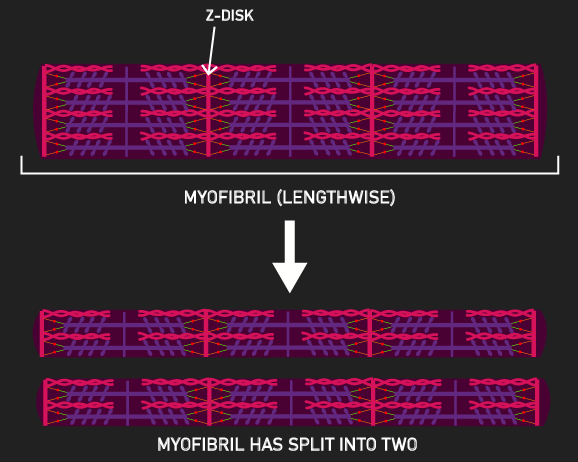
As we’ve explored in a previous article, it seems one of the primary ways muscles seem to grow is via an increase in the cross-sectional area of their muscle fibers.
There are 3 underlying ways a muscle fiber can increase in cross-sectional area: myofibrillar hypertrophy, sarcoplasmic hypertrophy, and myofibrillar packing.
As we have also done previously, when overviewing the evidence on these 3 underlying ways of muscle fiber growth, there is a good deal of evidence finding both myofibrillar hypertrophy and myofibrillar packing.
In this article, we’ll be going into some depth on the science of myofibrillar hypertrophy and packing.
Before we do this, it will be useful to review what myofibrillar hypertrophy, myofibrillar packing, as well as sarcoplasmic hypertrophy, are.
Table of Contents
Structure of a Muscle
Muscles are organized in hierarchical layers.
Within the whole muscle are fascicles, within fascicles are muscle fibers, and within muscle fibers are myofibrils.

Myofibrils are where the magic of muscle contraction happens, they consist of an array of sarcomeres.
Sarcomeres are what generate muscle force.
Specifically, when something called the myosin head extends from the myosin filament and pulls on something called the actin filament towards the M-line, force is generated.

B) The myosin heads extend from the myosin filaments and attach to the actin filaments.
C) The myosin filaments pull the actin filaments towards to M-line, shortening the sarcomere length.
To review the 3 underlying ways of muscle fiber growth, we need to return to the muscle fiber level.
As noted, muscle fibers contain myofibrils, which are what generate force via their sarcomeres.

Everything else within the muscle fiber can be considered the sarcoplasm.
The sarcoplasm largely consists of water but also contains other components, such as glycogen, sarcoplasmic proteins, and non-contractile organelles.
Myofibrillar hypertrophy is where the myofibrils and sarcoplasm grow at the same pace, meaning the relative space taken up by the myofibrils and sarcoplasm remains the same.

Sarcoplasmic hypertrophy is where the sarcoplasm grows at a greater pace than the myofibrils, meaning the relative space taken up by the sarcoplasm becomes greater.

Myofibrillar packing is where the myofibrils grow at a greater pace than the sarcoplasm, meaning the relative space taken up by the myofibrils becomes greater.

As we can see, central to both myofibrillar hypertrophy and myofibrillar packing is the growth of the myofibrils, and this is what we’ll be exploring in this article.
Specifically, how do myofibrils grow, and can you train for a certain type of myofibril growth?
Myofibrils can grow in three different ways: by increasing in length, increasing in cross-sectional area, or increasing in number.
Increase in Myofibril Length
Let us first explore how myofibrils may increase in length.
Firstly, in a previous article, we described how an increase in myofibril length can ultimately lead to an increase in whole muscle cross-sectional area.
Let us quickly review what was said.
There is a good deal of evidence that resistance training can increase the length of fascicles in humans.
Provided fascicles run the length of a whole muscle, an increase in their length would increase whole muscle length.
However, given whole muscles are attached to bones, and these attachment locations do not change, we never visually witness an increase in whole muscle length.
Rather, due to the fixed attachment locations, the longer muscle would bulge outwards, and this is an increase in cross-sectional area.

Now, this increase in whole muscle length is caused by an increase in fascicle length. But, what causes an increase in fascicle length in the first place?
Well, given muscle fibers are found within fascicles, an increase in muscle fiber length seems the most likely explanation.
At the muscle fiber level, we know myofibrils are present, and as we’ll get on to in a second, myofibrils likely increase in length.
Along with this increase in myofibril length, although I believe there’s no concrete evidence on it, presumably the sarcoplasm would expand lengthwise to support this myofibril length increase, thereby cementing an increase in muscle fiber length.
Given the myofibrils and sarcoplasm grow lengthwise at the same pace, it could technically be considered myofibrillar hypertrophy.
Anyway, returning our focus on the myofibril component, how would myofibrils increase in length?
As we know, myofibrils consist of an array of sarcomeres.
In theory, myofibrils could increase in length via increasing the length of pre-existing sarcomeres, or by increasing the number of sarcomeres in series.


When overviewing the animal research, the overwhelming evidence suggests that increasing the number of sarcomeres in series, not an increase in pre-existing sarcomere length, occurs with an increase in myofibril length (one, two, three, four, five, six, seven, eight, nine, and ten).
Note, I did say animal studies. Unfortunately, I don’t believe there are any studies exploring changes at the myofibril level in humans.
Largely, this is likely due to methodological and practical constraints of assessing ultrastructural changes with human subjects, hence we are relying on non-human animal studies.
This is a limitation that should be considered throughout this article.
But, the finding that increasing the number of sarcomeres in series is likely what creates an increase in myofibril length makes sense.
If you were to chronically increase the length of pre-existing sarcomeres, especially to a high degree, their ability to produce force is most likely compromised, and so this mechanism seems unlikely.
Where Is the Sarcomere Added?
Now, an interesting question is if an increase in the number of sarcomeres in series occurs, where is the sarcomere added along the length of the myofibril?
Some animal studies support the notion that the sarcomeres are simply added to the ends of pre-existing myofibrils. However, other animal studies suggest that new sarcomeres are inserted between pre-existing sarcomeres.
Therefore, the research is unfortunately not currently clear.
Before moving on, if you’re curious about creating an effective training program for muscle hypertrophy, our high quality partner Alpha Progression can help. It can generate a highly effective program for you, track your workouts live with in-built progression recommendations, provide graphs displaying your long term progress, and it has a massive exercise database with more than 550 exercises.
Click HERE (the link opens in a new tab) to get a free 2 week trial of the apps features. If you like it and go beyond, the link also gives you 20% off a subscription!
We never promote trash at the House of Hypertrophy, so rest assured the app is high quality. The reviews speak to this, 4.8 starts (based on more than 7,000 reviews) on Google play, and 4.9 stars in Apple’s store (based on nearly 400 ratings).
Can You Train for an Increase in Sarcomere in Series?
Another interesting question is whether you can specifically train to increase the number of sarcomeres in series.
It turns out that there may indeed be specific ways of training that predominantly induce this type of growth.
Returning to the animal studies that found an increase in the number of sarcomeres in series, nearly all of the studies stimulated the muscle at a long length.
Using various equipment, they either placed the muscle at a stretched position for a set duration or had the animals perform eccentric contractions. Eccentric contractions are where the muscle produces force while lengthening.
Now, the idea of simply placing a muscle in a stretched position for a set duration is likely not directly applicable to humans, as these studies either used extreme stretching training sessions or had the animals stretch for numerous days or weeks on end.
However, the idea of training a muscle at a long length, including eccentric training, may very well apply to humans.
For instance, McMahon et al. found that compared to training a range of lower body exercises with a partial range of motion that worked the muscles at a short length (specifically from 0 to 40 degrees of knee flexion), training with a fuller range of motion (from 0 to 90 degrees of knee flexion) produced greater increases in vastus lateralis fascicle length.
As we’ve established, presumably this increase in fascicle length ultimately reflects an increase in the number of sarcomeres in series.
Another study by McMahon et al. found that with knee extensions, using a partial range of motion that trained the quadriceps at long lengths (from 40 to 90 degrees of knee flexion) resulted in greater increases in vastus lateralis fascicle length compared to a partial range of motion that trained the quadriceps at short lengths (from 0 to 50 degrees of knee flexion).

Therefore, a full range of motion, or a partial range of motion that trains the muscle at long lengths, seems to be good at increasing fascicle length (and therefore presumably increasing the number of sarcomeres in series).
However, eccentric overload training may be even better.
For those unaware, your muscles are significantly stronger during the lowering phases of an exercise (in which your muscles are contracting eccentrically). Eccentric overload refers to using some method that enables you to lift heavier loads on the lowering phase of an exercise, thereby overloading the eccentric muscular contractions.
Reeves et al. found that compared to performing leg presses and knee extensions normally, performing them with overloaded eccentric repetitions only, produced greater increases in vastus lateralis fascicle length.
A few other studies also find that eccentric-only training is highly effective at increase fascicle length.
Therefore, if you have access to equipment or techniques that allow you to perform eccentric overloaded reps, this could be a highly effective way to preferentially stimulate an increase in the number of sarcomeres in series.
An Increase in Sarcomere in Series May Be Limited in Timeframe
Quite interestingly, there is some evidence suggesting that your ability to increase the number of sarcomeres in series may be restricted to a certain timeframe.
Baroni et al. recruited untrained subjects and had them train eccentric overloaded knee extensions for 12 weeks. Vastus lateralis and rectus femoris fascicle length increased up until week 8, with no further increases observed thereafter.
Similarly, Blazeich et al. recruited untrained subjects and had them train knee extensions for 10 weeks. Vastus lateralis fascicle length increased up until the 5th week, with no further increases observed thereafter.
Therefore, perhaps your ability to increase fascicle length (and therefore presumably increase the number of sarcomeres in series) may be limited to the first few weeks or months of training.
However, these are only two studies. Future research is undoubtedly still required, and questions still remain, for instance, in highly trained individuals who have never performed eccentric overloaded training, could they still experience an increase in the number of sarcomeres in series via eccentric overloaded training?
All of the mentioned eccentric overload studies were only conducted on untrained subjects.
Increase In Myofibril Cross-Sectional Area & Number
Let us now move away from how myofibrils may increase in length, and progress on to how myofibrils may increase in cross-sectional area or number.
Firstly, it seems most likely that myofibrils increase in cross-sectional area via increasing sarcomeres in parallel. This suggests sarcomeres are built and added above or below pre-existing sarcomeres, thereby increasing the cross-sectional area of the myofibril.

As for an increase in myofibril number, this suggests that either completely new myofibrils are manufactured and added to muscle fibers, or pre-existing myofibrils split into two.
So, what is the evidence for either of these?
It’s very well established in human studies that muscle fibers increase in cross-sectional area in response to resistance training.
And demonstrated in a previous article, there is a good deal of evidence this fiber growth can be achieved by myofibrillar hypertrophy or myofibrillar packing.
As we know, both of these underlying fiber growths involve significant myofibril growth.
This growth of the myofibrils could be achieved by an increase in cross-sectional area of the individual myofibrils, or by an increase in the number of myofibrils.
However, which one actually takes place?
Unfortunately, I don’t believe there are any human studies exploring this.
Again, this is likely due to methodological and practical constraints of assessing ultrastructural changes with human subjects, hence we are relying on animal studies.
Surprisingly, even with animal studies, there appears to be very little research in this area.
By my count, there seem to be only 2 relevant collections of research.
Ashmore and Summers conducted a few experiments exploring the effects of overloading the muscles of chickens, via stretching their wings for 1 week.
They found this procedure induced a 55% increase in muscle fiber cross-sectional area, and in a different experiment, an increase in the diameter of myofibrils by 36%. Moreover, 45% of the myofibrils displayed signs of splitting.
Therefore, this study suggests with an increase in muscle fiber cross-sectional area, myofibrils increase in diameter (which implies an increase in cross-sectional area, presumably through an increase in sarcomeres in parallel) AND pre-existing myofibrils may also split, as numerous myofibrils displayed signs of this.
Research by Goldspink further supports these findings.
Goldspink found that in mice of various ages, there was a positive relationship between the diameter of individual myofibrils and muscle fiber cross-sectional area.
As a larger myofibril diameter suggests a larger myofibril cross-sectional area, this data supports the notion that myofibrils may increase in cross-sectional area as muscle fibers increase in cross-sectional area.
However, Goldspink also found a similar positive relationship between the number of myofibrils in a muscle fiber and the muscle fiber’s cross-sectional area.
Therefore, it seems that myofibrils may also increase in number as the muscle fiber increases in cross-sectional area.
Further work by Goldspink indicated that the increase in myofibril number was likely due to the splitting of pre-existing myofibrils.
Specifically, and quite fascinatingly, Goldspink put forth the idea that individual myofibrils may increase in cross-sectional area (via an increase in sarcomeres in parallel) up to a certain critical size. Thereafter, this myofibril splits into two.
Supporting this was the finding that Goldspink observed splitting in myofibrils roughly twice the size of myofibrils that were not splitting.
To add some more detail, at the myofibril level, Goldspink’s research supports the idea that myofibrils would split longitudinally, via a break at the Z-discs of sarcomeres.

So collectively the studies by Ashmore, Summers, and Goldspink suggest that with an increase in muscle fiber cross-sectional area, an increase in the cross-sectional area of individual myofibrils (likely via an increase in sarcomere in parallel), as well as an increase in myofibril number ( likely via splitting of pre-existing myofibrils), occurs.
At the moment, there appears to be no research suggesting completely new myofibrils can be created and added to muscle fibers.
Can You Train For an Increase in Myofibril Cross-Sectional Area or Number?
Let us move on to the intriguing question of whether you can train specifically for an increase in myofibril cross-sectional area or number.
Given the current evidence suggests an increase in myofibril cross-sectional area and number may both occur and may be linked (as suggested by Goldsprink’s research), we’ll consider them as one.
Overall, opposed to the research on how you may increase myofibril length, the current research does not seem to provide any clear details behind how you may specifically target an increase in myofibril cross-sectional area or number.
Despite this, we still could draw some potential conclusions indirectly.
As we saw in a previous article, there’s a good deal of evidence supporting the notion that an increase in muscle fiber cross-sectional area is achieved via myofibrillar hypertrophy or packing, suggesting a significant increase in myofibril cross-sectional area and/or number.
The large majority of the studies finding this used moderate loadings, moderate frequencies, and low to moderate volumes.
The definitions for each of these can be seen below.

Therefore, one could suggest that training with these variables may optimize an increase in myofibril cross-sectional area or number.
However, I should mention the majority of studies that found sarcoplasmic hypertrophy (that is, greater growth of the sarcoplasm compared to the myofibrils) also used moderate loads and moderate frequencies.
Thus, these using these variables may not be tied to myofibrillar hypertrophy or myofibrillar packing.
On the other hand, though, the majority of the studies finding sarcoplasmic hypertrophy used higher volumes.
From this, we can perhaps deduce using low to moderate volumes produce myofibrillar hypertrophy or packing.
Now, it’s important to emphasize these suggestions are tentative, there are potential limitations with them.
One noteworthy point is that there’s currently a lack of research exploring the exclusive use of heavy or light loads on the 3 underlying ways of muscle fiber growth.
Therefore, it remains possible that either heavy or light loads could preferentially elicit myofibrillar hypertrophy or packing.
All in all, future research would be needed to provide greater clarity on this area.
Remember to feel free to check out the Alpha Progression App if you’re interested. Also feel free to check out our free bench press e-book below.

